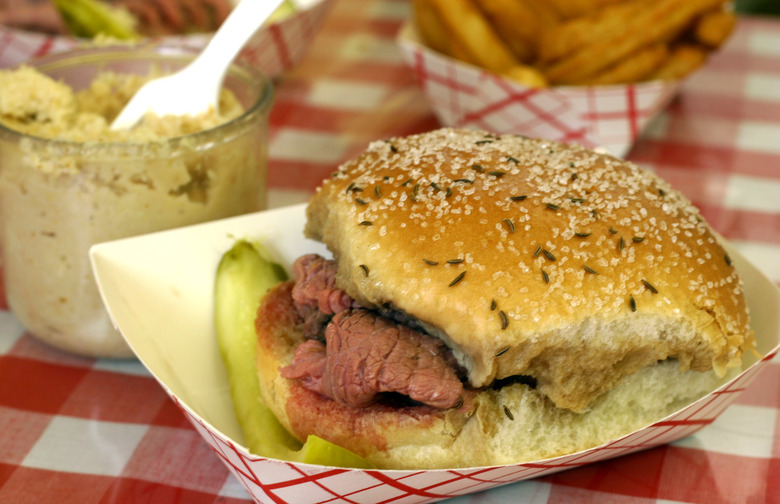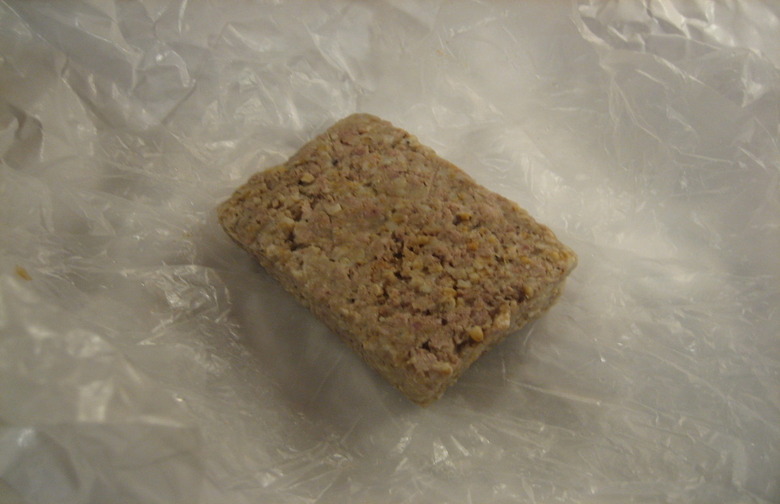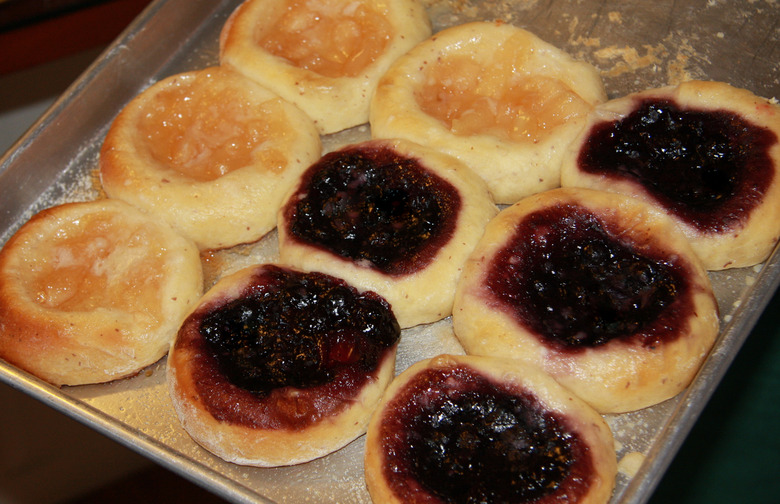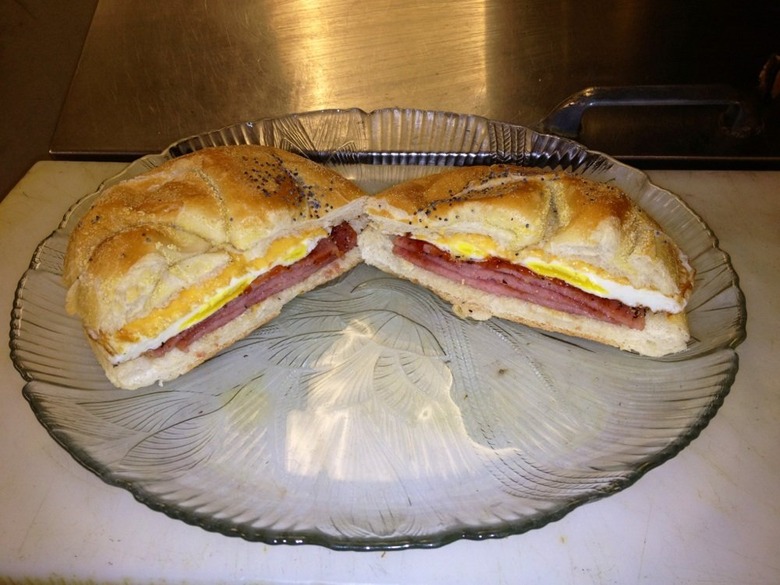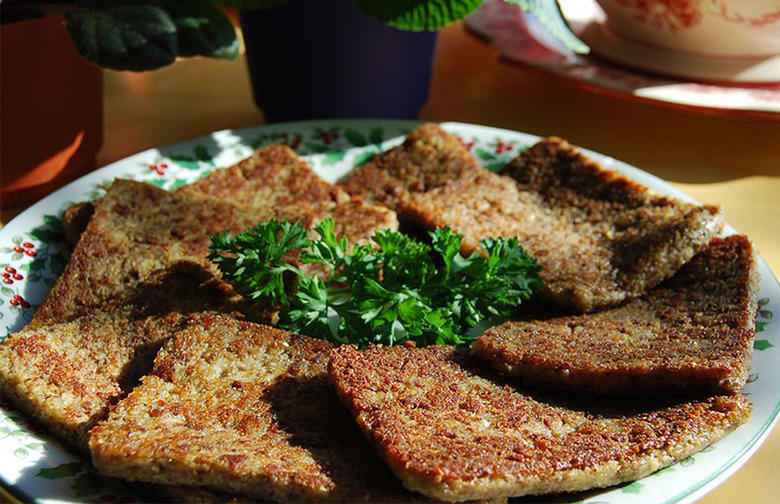Loose Meat, Hot Dish, And 13 Other Regional Comfort Foods You Didn't Know Existed
In today's day and age, it seems like you can find just about any type of food you want, especially if you live in a big city. Want a super-authentic banh mi, or perhaps a traditional Belgian Liège waffle? There's a food truck for that. Heck, even if you live in the middle of nowhere you can log on to a half-dozen food delivery sites and order food items right off the menu from some of the country's most legendary restaurants. But there are still plenty of regional specialties that we bet you didn't know existed, and we tracked down 15 of them.
Loose Meat
Also called a slightly more appealing "tavern sandwich," this Iowa specialty is what you might think of as a cross between a burger and a sloppy joe. Instead of being formed into a patty, ground beef is cooked loose into small crumbles, simply seasoned (and occasionally mixed with onions), and scooped onto a bun. Taylor's Made-Rite in Marshalltown, Iowa, is the restaurant that's best known for this messy and delicious creation.
Hotdish
If you're going to a church supper, potluck, or family reunion in Minnesota and other parts of the Upper Midwest, you're most likely bringing a hotdish. This infinitely versatile casserole is usually made by mixing meat, vegetables, and a binder (usually something along the lines of ground beef, canned green beans, and canned cream of mushroom soup), topping it with tater tots, and baking it until golden brown and bubbly. While there are countless variations, you always know a hotdish when you see one.
Scrapple
In the Mid-Atlantic states including Pennsylvania, Maryland, and Delaware, a traditional food of the Pennsylvania Dutch is easy to track down: scrapple. It's made by combining pork scraps and trimmings with cornmeal and seasonings, blending it into a mush, forming it into a loaf, letting it congeal, then slicing and pan-frying before serving. Don't knock it until you try it: The first recipes date back to the 1600s, and it's been perfected over the years, so it's pretty tasty. It's also nothing short of beloved: There's even an annual scrapple festival.
Runza
There are more than 50 locations of the Runza chain in and around Lincoln, Nebraska, as well as one in Colorado, two in Iowa, and two in Kansas. Outside of that you're simply not going to find their signature item, also known as the runza. Sort of like a Hot Pocket on steroids, the Runza is a hot stuffed sandwich with Russian and Germanic origins, with the dough completely enveloping the filling. The classic, original runza is filled with a mixture of ground beef, onions, and cabbage, but the chain also sells them in cheese, Swiss mushroom, cheeseburger, and barbecue bacon varieties.
Goetta
Cincinnati has a handful of regional specialties, most notably its famous chili-topped spaghetti. But there's a regional food that's just as popular but not nearly as famous, and it's a German-influenced sausage known as goetta. A fine-ground mixture of ground pork, oats, and spices, the most popular variety is sold by Glier's, which produces more than 1 million pounds of the stuff annually, with nearly 100 percent of it being consumed in the Cincinnati area. It was typically a breakfast food, but you'll find goetta burgers, hot dogs, and pizza in the area; of course, there's also a Goettafest.
Kolaches
Kolaches are a type of filled dough with Czech roots that have become very popular in many parts of Texas, as well as parts of Iowa, Wisconsin, and Minnesota. The majority of the ones you'll find envelop a dollup of fruit with soft, semisweet dough and are eaten for dessert or as a breakfast pastry, but some also include meat, bacon and eggs, and basically anything else the baker wants to include. Though they're most popular in Texas, word is finally starting to spread: There's not one but two shops specializing in them in (where else?) Brooklyn.
Pork Roll
The pork roll (also known as Taylor ham) is a thing of pride for New Jerseyans, who know that in the canon of breakfast meats, it's right up there with bacon. It's a slightly smoky sausage that resembles bologna, and it's typically sliced and pan-fried or grilled before being partnered with egg and cheese on a roll, in a crazy-good gutbuster of a sandwich known as the Jersey Breakfast.
Cheese Crisp
Visit any Mexican restaurant in the Phoenix area, and you'll find an intriguing-sounding appetizer on the menu: cheese crisp. Order it, and at first glance you might think that a pizza is being brought to your table. Actually, it's a massive four tortilla topped with shredded cheese and broiled until the cheese melts and the edges crisp up, sliced into wedges. Most restaurants will let you top it with jalapeños, steak, chicken, etc., but it's really best enjoyed as-is.
Loco Moco
Loco Moco is a true Hawaiian specialty, a local comfort food made by topping white rice with a hamburger patty, a fried egg, and gravy (a slice of Spam doesn't hurt, either). Two restaurants in Hilo, Hawaii, continue to battle over who popularized the dish in the 1940s — Café 100 and the Lincoln Grill.
Beef on Weck
A roast beef sandwich that dreams are made of, French dip lovers will love beef on weck. A hallmark sandwich of the Buffalo, New York area, beef on weck starts with rare, thinly sliced roast beef, tucked into a roll called a kummelweck, which has been dusted with coarse salt and caraway seeds. The top bun gets a dip in beef jus, and the only condiment is a hefty spoonful of horseradish.
Gerber Sandwich
Invented in 1973 at a St. Louis deli by a customer named Dick Gerber and now found at many St. Louis-area restaurants, this open-faced sandwich starts with a halved loaf of Italian or French bread, smeared with garlic butter, topped with ham, cheese (usually provolone or another local specialty, Provel), and some paprika, and then toasted.
Livermush
This Southern specialty, most popular in the western part of North Carolina, is similar to scrapple but contains a lot more liver. It also contains cornmeal, pepper, and sage, and is prepared by frying up a slice in oil. It's most commonly served as a breakfast item alongside grits and eggs.
Chow Chow
This pickle relish is popular in scattered parts of the U.S., including parts of the South, Pennsylvania, New Mexico, and Appalachia, but little-known outside of there. Made with a wide variety of finely chopped vegetables (which may include cabbage, green tomatoes, chayote, onions, beans, and carrots) pickled in vinegar and flavored with mustard, red pepper, and a variety of other spices, it's one of the most versatile condiments around; we're especially fond of it atop hot dogs and pulled pork.
Garbage Plate
Insanely popular in the Rochester, New York, area but little-known outside of it, the garbage plate gets its name because of the huge quantity and variety of food piled onto a plate. Widely credited with being created at a restaurant there called Nick Tahou's Hots, it's prepared by starting with either baked beans or macaroni salad, then piling on home fries or French fries. It's then topped with your choice of two of the following: hamburger, cheeseburger, Italian sausage, red hot or white hot (local hot dog variations), chicken tenders, haddock, fried eggs, ham, or a grilled cheese. Then it's topped with onions, mustard, and beef chili sauce. Hangovers be damned.
Frogmore Stew
This classic Low Country, South Carolina, dish (also called Low Country boil or Beaufort stew) is the perfect way to enjoy the region's ample culinary offerings. Similar to your standard seafood boil, it only needs to contain two ingredients to be called Frogmore stew: fresh Carolina shrimp and yellow corn, but most variations also contain redskin potatoes, sausage, and occasionally crabs, with lemon juice and Old Bay seasoning. Like most proper boils, it's dumped out onto a newspaper-topped table and served on paper plates with plenty of cold beer.
